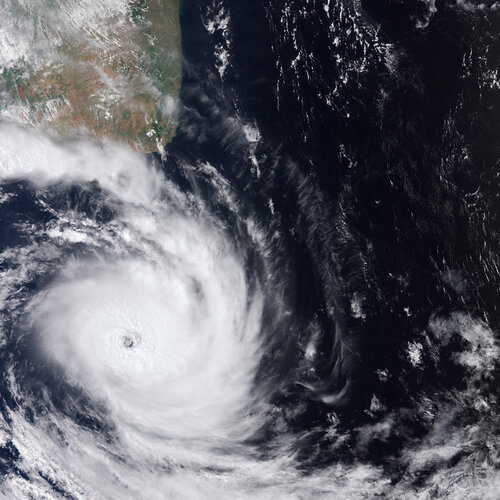The Copernicus Sentinel-3 mission captured Cyclone Dikeledi south of Madagascar on 16 January, just a few days after it made landfall on Africa’s southeastern coast causing widespread destruction in several countries and islands.
Zoom in to explore this image at its full resolution.
Cyclone Dikeledi originated as a tropical storm between Indonesia and Australia at the start of the year. Since then, it has travelled westwards across the Indian Ocean, gradually increasing in strength to become a cyclone when it first struck northern Madagascar on 11 January.
In the following days, Dikeledi hit other parts of southeastern Africa, including Mozambique, Comoros and Mayotte. The French territory was still recovering from Cyclone Chido, which inflicted significant damage on the region in December.
Earth observation satellites provide indispensable data on events that cover entire regions, as shown here from Copernicus Sentinel-3. The width of the storm in this image is estimated to be around 500 km, while the eye is around 25 km. The mission is designed to measure, monitor and understand global dynamics on a large scale and provides essential information in near-real time for ocean and weather forecasting.
In this image, acquired with the mission’s Ocean and Land Colour Instrument, the cyclone can be seen moving away from the Mozambique Channel, skirting the southern part of Madagascar, which is visible in the top left corner of the image.
Tropical cyclones originate over warm oceans. When they form in the northern hemisphere, they are referred to as hurricanes or typhoons, while those forming in the southern hemisphere are called cyclones.



 Image:
The Copernicus Sentinel-3 mission captured Cyclone Dikeledi south of Madagascar on 16 January, just a few days after it made landfall on Africa’s southeastern coast causing widespread destruction in several countries and islands.
Image:
The Copernicus Sentinel-3 mission captured Cyclone Dikeledi south of Madagascar on 16 January, just a few days after it made landfall on Africa’s southeastern coast causing widespread destruction in several countries and islands.